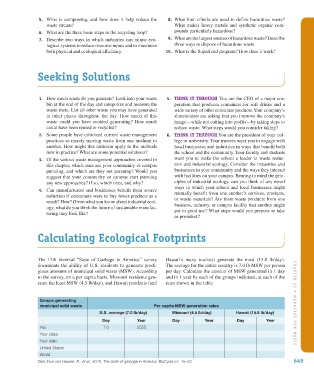Page 650 - Environment: The Science Behind the Stories
P. 650
5. What is composting, and how does it help reduce the 8. What four criteria are used to define hazardous waste?
waste stream? What makes heavy metals and synthetic organic com-
6. What are the three basic steps in the recycling loop? pounds particularly hazardous?
7. Describe two ways in which industries can mimic eco- 9. What are the largest sources of hazardous waste? Describe
logical systems to reduce resource inputs and to maximize three ways to dispose of hazardous waste.
both physical and ecological efficiency. 10. What is the Superfund program? How does it work?
Seeking Solutions
1. How much waste do you generate? Look into your waste 5. THINK IT THROUGH You are the CEO of a major cor-
bin at the end of the day and categorize and measure the poration that produces containers for soft drinks and a
waste there. List all other waste you may have generated wide variety of other consumer products. Your company’s
in other places throughout the day. How much of this shareholders are asking that you improve the company’s
waste could you have avoided generating? How much image—while not cutting into profits—by taking steps to
could have been reused or recycled? reduce waste. What steps would you consider taking?
2. Some people have criticized current waste management 6. THINK IT THROUGH You are the president of your col-
practices as merely moving waste from one medium to lege or university. Your trustees want you to engage with
another. How might this criticism apply to the methods local businesses and industries in ways that benefit both
now in practice? What are some potential solutions? the school and the community. Your faculty and students
3. Of the various waste management approaches covered in want you to make the school a leader in waste reduc-
this chapter, which ones are your community or campus tion and industrial ecology. Consider the industries and
pursuing, and which are they not pursuing? Would you businesses in your community and the ways they interact
suggest that your community or campus start pursuing with facilities on your campus. Bearing in mind the prin-
any new approaches? If so, which ones, and why? ciples of industrial ecology, can you think of any novel
ways in which your school and local businesses might
4. Can manufacturers and businesses benefit from source mutually benefit from one another’s services, products,
reduction if consumers were to buy fewer products as a or waste materials? Are there waste products from one
result? How? Given what you know about industrial ecol- business, industry, or campus facility that another might
ogy, what do you think the future of sustainable manufac- put to good use? What steps would you propose to take
turing may look like?
as president?
Calculating Ecological Footprints
The 17th biennial “State of Garbage in America” survey Hawaii’s many tourists) generate the most (15.8 lb/day).
documents the ability of U.S. residents to generate prodi- The average for the entire country is 7.0 lb MSW per person
gious amounts of municipal solid waste (MSW). According per day. Calculate the amount of MSW generated in 1 day
to the survey, on a per capita basis, Missouri residents gen- and in 1 year by each of the groups indicated, at each of the
erate the least MSW (4.5 lb/day), and Hawaii residents (and rates shown in the table.
Groups generating
municipal solid waste Per capita MSW generation rates CHAPTER 22 • MAN A GING OUR WASTE
U.S. average (7.0 lb/day) Missouri (4.5 lb/day) Hawaii (15.8 lb/day)
Day Year Day Year Day Year
You 7.0 2555
Your class
Your state
United States
World
Data from van Haaren, R., et al., 2010. The state of garbage in America. BioCycle 51: 16–23. 649
M22_WITH7428_05_SE_C22.indd 649 13/12/14 2:25 PM

